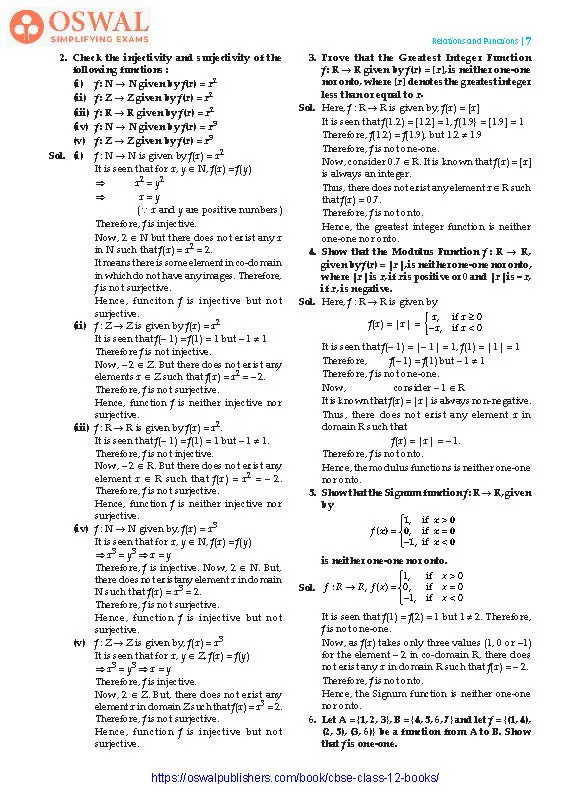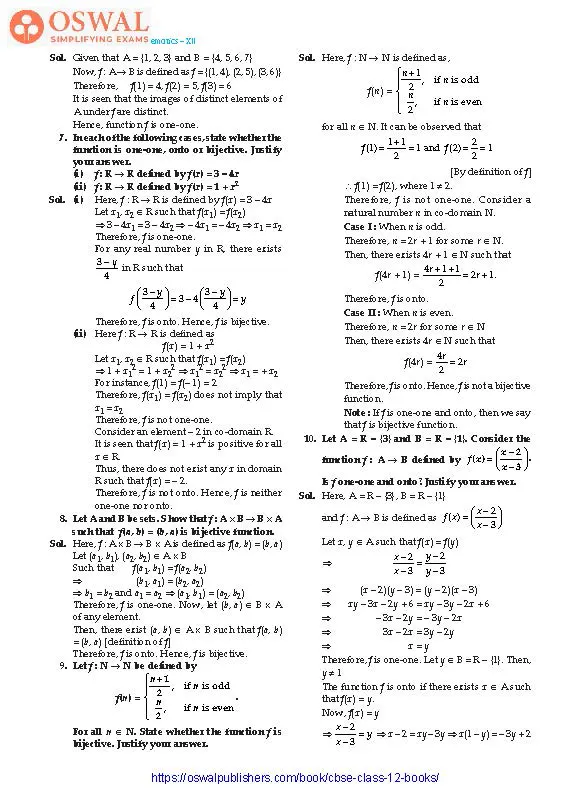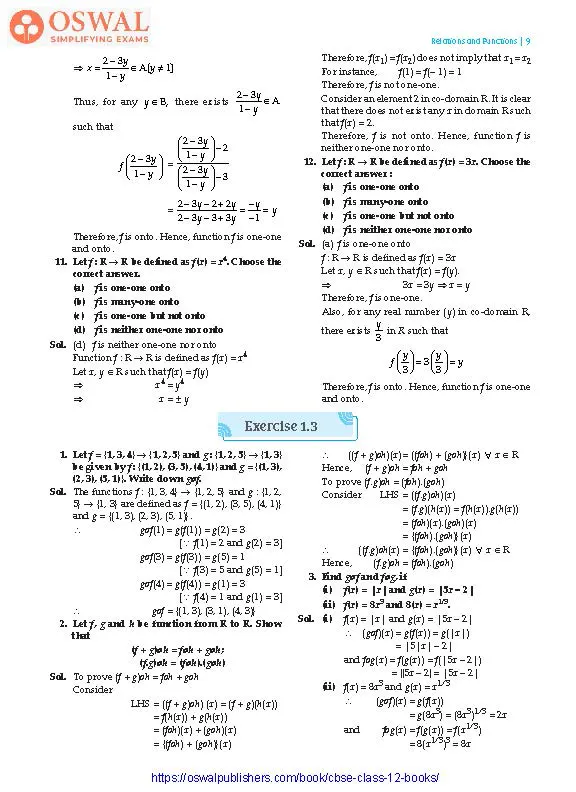NCERT Solutions for Class 12 Maths Chapter 1 - Relations and Functions - Exercise 1.2




Access Exercises of Class 12 Maths Chapter 1 - Relations and Functions
Exercise 1.1 Solutions : 16 Questions (14 Short Answers, 2 MCQ)
Exercise 1.2 Solutions : 12 Questions (10 Short Answers, 2 MCQ)
Exercise 1.3 Solutions : 14 Questions (12 Short Answers, 2 MCQ)
Exercise 1.4 Solutions : 13 Questions (12 Short Answers, 1 MCQ)
Miscellaneous Exercise Solutions: 19 Questions (7 Long answers, 9 Short Answer Type, 3 MCQs)
Exercise 1.2 :
1. Show that the function f : R, → R, defined by f( x)=1/x is one-one and onto, where R* is the set of all non-zero real numbers. Is the result true, if the domain R, is replaced by N with co-domain being same as R, ?
$$\textbf{Sol.}\space \text{It is given that f : R → R is defined by}\\f(x)=\frac{1}{x}.\\\text{For one-one,}\space f(x) = f(y)\\⇒\frac{1}{x}=\frac{1}{y}\\⇒ x = y\\\text{Therefore, f is one-one.}\\\textbf{For onto,}\\\text{It is clear that for y ∈ R, there exists}\space x=\frac{1}{y} ∈ R.\\\text{(Exists as} y ≠ 0) \text{such that}\\f(x)=\frac{1}{(\frac{1}{y})}=y\\\text{Therefore, f is onto.}\\\text{Thus, the given function (f) is one-one and onto.}\\\text{ Now, consider function g : N → R* defined by}$$
$$f(x)=\frac{1}{\frac{1}{y}}=y\\\text{Therefore, f is onto. Thus, the given function (f) is one-one and onto.}\\\text{Now, consider function g : N → R defined by}\\g(x)=\frac{1}{x}\\\text{We have}, g(x_1) = g(x_2)\\⇒\frac{1}{x_1}=\frac{1}{x_2}\\⇒ x_1 = x_2\\\text{Therefore, g is one-one.}\\\text{Further, it is clear that g is not onto as for}\\\text{1.2 ∈ R, there does not exist any x in N such that}\\g(x) =\frac{1}{1.2}\\\text{Hence, function g is one-one but not onto.}$$
2. Check the injectivity and surjectivity of the following functions :
(i) f : N → N given by f(x) = x2
(ii) f : Z → Z given by f(x) = x2
(iii) f : R → R given by f(x) = x2
(iv) f : N → N given by f(x) = x3
(v) f : Z → Z given by f(x) = x3
Sol. (i) f : N → N is given by f(x) = x2
It is seen that for x, y ∈ N, f(x) = f(y)
⇒ x2 = y2
⇒ x = y
(∴ x and y are positive numbers) Therefore, f is injective.
Now, 2 ∈ N but there does not exist any x in N such that f(x) = x2 = 2.
It means there is some element in co-domain in which do not have any images. Therefore, f is not surjective.
Hence, funciton f is injective but not surjective.
(ii) f : Z → Z is given by f(x) = x2
It is seen that f(– 1) = f(1) = 1 but – 1 ≠ 1 Therefore f is not injective.
Now, – 2 ∈ Z. But there does not exist any elements x ∈ Z such that f(x) = x2 = – 2.
Therefore, f is not surjective.
Hence, function f is neither injective nor surjective.
(iii) f : R → R is given by f(x) = x2.
It is seen that f(– 1) = f(1) = 1 but – 1 ≠ 1.
Therefore, f is not injective.
Now, – 2 ∈ R. But there does not exist any element x ∈ R such that f(x) = x2 = – 2.
Therefore, f is not surjective.
Hence, function f is neither injective nor surjective.
(iv) f : N → N given by, f(x) = x3
It is seen that for x, y ∈ N, f(x) = f(y)
⇒ x3 = y3 ⇒ x = y
Therefore, f is injective. Now, 2 ∈ N. But, there does not existany element x in domain N such that f(x) = x3 = 2.
Therefore, f is not surjective.
Hence, function f is injective but not surjective.
(v) f : Z → Z is given by, f(x) = x3
It is seen that for x, y ∈ Z, f(x) = f(y)
⇒ x3 = y3 ⇒ x = y
Therefore, f is injective.
Now, 2 ∈ Z. But, there does not exist any element x in domain Z such that f(x) = x3 = 2.
Therefore, f is not surjective.
Hence, function f is injective but not surjective.
3. Prove that the Greatest Integer Function f : R → R given by f(x) = [x], is neither one-one nor onto, where [x] denotes the greatest integer less than or equal to x.
Sol. Here, f : R → R is given by, f(x) = [x]
It is seen that f(1.2) = [1.2] = 1, f(1.9} = [1.9] = 1
Therefore, f(1.2) = f(1.9), but 1.2 ≠ 1.9 Therefore, f is not one-one.
Now, consider 0.7 ∈ R. It is known that f(x) = [x] is always an integer.
Thus, there does not exist any element x ∈ R such that f(x) = 0.7.
Therefore, f is not onto.
Hence, the greatest integer function is neither one-one nor onto.
4. Show that the Modulus Function f : R → R, given by f(x) = |x|, is neither one-one nor onto, where |x| is x, if x is positive or 0 and |x| is – x, if x, is negative.
Sol. Here, f : R → R is given by
$$f(x)=|x|=\begin{cases}x &\text{if\space x≥0 }\\-x &\text{\space if\space x<0}\end{cases}$$
It is seen that f(– 1) = |– 1| = 1, f(1) = |1| = 1
Therefore, f(– 1) = f(1) but – 1 ≠ 1
Therefore, f is not one-one.
Now, consider – 1 ∈ R
It is known that f(x) = |x| is always non-negative.
Thus, there does not exist any element x in domain R such that f(x) = |x| = – 1.
Therefore, f is not onto.
Hence, the modulus functions is neither one-one nor onto.
5. Show that the Signum function f : R → R, given by
$$f(x)=\begin{cases}1 &\text{if\space x>0 }\\0, &\text{\space if\space x=0}\\-1 &\text{\space if\space x<0}\end{cases}$$
is neither one-one nor onto.
$$\textbf{Sol.}\space f: R→R,f (x)=\begin{cases}1 &\text{if\space x>0 }\\0, &\text{\space if\space x=0}\\-1 &\text{\space if\space x<0}\end{cases}$$
It is seen that f(1) = f(2) = 1 but 1 ≠ 2. Therefore, f is not one-one.
Now, as f(x) takes only three values (1, 0 or –1) for the element – 2 in co-domain R, there does not exist any x in domain R such that f(x) = – 2.
Therefore, f is not onto.
Hence, the Signum function is neither one-one nor onto.
6. Let A = {1, 2, 3}, B = {4, 5, 6, 7} and let f = {(1, 4), (2, 5), (3, 6)} be a function from A to B. Show that f is one-one.
Sol. Given that A = {1, 2, 3} and B = {4, 5, 6, 7}
Now, f : A → B is defined as f = {(1, 4), (2, 5), (3, 6)}
Therefore, f(1) = 4, f(2) = 5, f(3) = 6
It is seen that the images of distinct elements of A under f are distinct.
Hence, function f is one-one.
7. In each of the following cases, state whether the function is one-one, onto or bijective. Justify your answer.
(i) f : R → R defined by f(x) = 3 – 4x
(ii) f : R → R defined by f(x) = 1 + x2
Sol. (i) Here, f : R → R is defined by f(x) = 3 – 4x
Let x1, x2 ∈ R such that f(x1) = f(x2)
⇒ 3 – 4x1 = 3 – 4x2
⇒ – 4x1 = – 4x2
⇒ x1 = x2
Therefore, f is one-one.
For any real number y in R, there exists
$$\frac{3-y}{4}\space\text{in R such that}\\f(\frac{3-y}{4})=3-4(\frac{3-y}{4})=y$$
Therefore, f is onto. Hence, f is bijective.
(ii) Here f : R → R is defined as
f(x) = 1 + x2
Let x1, x2 ∈ R such that f(x1) = f(x2)
⇒ 1 + x12
= 1 + x2 2
⇒ x12
= x22
⇒ x1 = + x2
For instance, f(1) = f(– 1) = 2
Therefore, f(x1) = f(x2) does not imply that
x1 = x2
Therefore, f is not one-one.
Consider an element – 2 in co-domain R.
It is seen that f(x) = 1 + x2 is positive for all
x ∈ R.
Thus, there does not exist any x in domain
R such that f(x) = – 2.
Therefore, f is not onto. Hence, f is neither
one-one nor onto.
8. Let A and B be sets. Show that f : A × B → B × A such that f(a, b) = (b, a) is bijective function.
Sol. Here, f : A × B → B × A is defined as f(a, b) = (b, a)
Let (a1, b1), (a2, b2) ∈ A × B
Such that f(a1, b1) = f(a2, b2)
⇒ (b1, a1) = (b2, a2)
⇒ b1 = b2 and a1 = a2
⇒ (a1, b1) = (a2, b2)
Therefore, f is one-one. Now, let (b, a) ∈ B × A of any element.
Then, there exist (a, b) ∈ A × B such that f(a, b)
= (b, a) [definition of f]
Therefore, f is onto. Hence, f is bijective.
9. Let f : N → N be defined by
$$f (n)=\begin{cases}\frac{n+1}{2}, &\text{if is odd }\\\frac{n}{2}, &\text{if is even}\end{cases}$$
Sol. Here, f : N → N is defined as,
$$f (n)=\begin{cases}\frac{n+1}{2}, &\text{if is odd }\\\frac{n}{2}, &\text{if is even}\end{cases}$$
for all n ∈ N. It can be observed that
$$f (1)=\frac{1+1}{2}=1 \space and f (2)=\frac{2}{2}=1\\\space\text{[By definition of f]}$$
∴ f(1) = f(2), where 1 ≠ 2.
Therefore, f is not one-one. Consider a natural number n in co-domain N.
Case I : When n is odd.
Therefore, n = 2r + 1 for some r ∈ N.
Then, there exists 4r + 1 ∈ N such that
$$f(4r + 1)=\frac{4r+1+1}{2}=2r+1.$$
Therefore, f is onto.
Case II : When n is even.
Therefore, n = 2r for some r ∈ N
Then, there exists 4r ∈ N such that
$$f(4r)=\frac{4r}{2}=2r$$
Therefore, f is onto. Hence, f is not a bijective function.
Note : If f is one-one and onto, then we say that f is bijective function.
10. Let A = R – {3} and B = R – {1}. Consider the function f : A → B defined by
$$f(x)=(\frac{x-2}{x-3})$$
Is f one-one and onto? Justify your answer.
Sol. Here, A = R – {3}, B = R – {1}
and f : A → B is defined as
$$f(x)=(\frac{x-2}{x-3})$$
Let x, y ∈ A such that f(x) = f(y)
$$⇒ \frac{x-2}{x-3}=\frac{y-2}{y-3}$$
⇒ (x – 2)(y – 3) = (y – 2)(x – 3)
⇒ xy – 3x – 2y + 6 = xy – 3y – 2x + 6
⇒ – 3x – 2y = – 3y – 2x
⇒ 3x – 2x = 3y – 2y
⇒ x = y
Therefore, f is one-one. Let y ∈ B = R – {1}. Then,
y ≠ 1
The function f is onto if there exists x ∈ A such
that f(x) = y.
Now, f(x) = y
$$⇒ \frac{x-2}{x-3}=y$$
⇒ x – 2 = xy – 3y ⇒ x(1 – y) = – 3y + 2
$$⇒ x= \frac{2-3y}{1-y}\epsilon\space A[y=1]\\\text{Thus, for any y}\epsilon B,\text{ there exists}\frac{2-3y}{1-y}\epsilon A\\\text{such that}\\f(\frac{2-3y}{1-y})=\cfrac{(\frac{2-3y}{1-y})-2}{(\frac{2-3y}{1-y})-3}\\=\frac{2-3y-2+2y}{2-3y-3+3y}\\=\frac{-y}{-1}=y$$
Therefore, f is onto. Hence, function f is one-one and onto.
11. Let f : R → R be defined as f(x) = x4. Choose the correct answer.
(a) f is one-one onto
(b) f is many-one onto
(c) f is one-one but not onto
(d) f is neither one-one nor onto
Sol. (d) f is neither one-one nor onto
Function f : R → R is defined as f(x) = x4
Let x, y ∈ R such that f(x) = f(y)
⇒ x4 = y4
⇒ x = ± y
Therefore, f(x1) = f(x2) does not imply that x1 = x2 For instance, f(1) = f(– 1) = 1
Therefore, f is not one-one.
Consider an element 2 in co-domain R. It is clear that there does not exist any x in domain R such that f(x) = 2.
Therefore, f is not onto. Hence, function f is neither one-one nor onto.
12. Let f : R → R be defined as f(x) = 3x. Choose the correct answer :
(a) f is one-one onto
(b) f is many-one onto
(c) f is one-one but not onto
(d) f is neither one-one nor onto
Sol. (a) f is one-one onto
f : R → R is defined as f(x) = 3x
Let x, y ∈ R such that f(x) = f(y).
⇒ 3x = 3y ⇒ x = y
Therefore, f is one-one.
Also, for any real number (y) in co-domain R,
$$\text{there exists}\frac{y}{3}\text{in R such that}\\f(\frac{y}{3})=3(\frac{y}{3})=y$$
Therefore, f is onto. Hence, function f is one-one and onto.
Share page on
NCERT Solutions Class 12 Mathematics
- Chapter 1 Relations and Functions
- Chapter 2 Inverse Trigonometric Functions
- Chapter 3 Matrices
- Chapter 4 Determinants
- Chapter 5 Continuity and Differentiability
- Chapter 6 Application of Derivatives
- Chapter 7 Integrals
- Chapter 8 Applications of the Integrals
- Chapter 9 Differential Equations
- Chapter 10 Vectors
- Chapter 11 Three-Dimensional Geometry
- Chapter 12 Linear Programming
- Chapter 13 Probability
CBSE CLASS 12 NCERT SOLUTIONS
- NCERT Solutions Class 12 English Core
- NCERT Solutions Class 12 Physics
- NCERT Solutions Class 12 Chemistry
- NCERT Solutions Class 12 Biology
- NCERT Solutions Class 12 Business Studies
- NCERT Solutions Class 12 Mathematics
- NCERT Solutions Class 12 Accountancy
- NCERT Solutions Class 12 Economics
- NCERT Solutions Class 12 Geography
- NCERT Solutions Class 12 History
- NCERT Solutions Class 12 Political Science
CBSE CLASS 12 SYLLABUS
- CBSE Class 12 English core Syllabus
- CBSE Class 12 Mathematics Syllabus
- CBSE Class 12 Physics Syllabus
- CBSE Class 12 Chemistry Syllabus
- CBSE Class 12 Biology Syllabus
- CBSE Class 12 Accountancy Syllabus
- CBSE Class 12 Business Studies Syllabus
- CBSE Class 12 Economics Syllabus
- CBSE Class 12 History Syllabus
- CBSE Class 12 Geography Syllabus
- CBSE Class 12 Political science Syllabus
- CBSE Class 12 Sociology Syllabus
- CBSE Class 12 Psychology Syllabus
- CBSE Class 12 Physical education Syllabus
- CBSE Class 12 Applied mathematics Syllabus
- CBSE Class 12 History of Indian Arts Syllabus
CBSE CLASS 12 Notes
- CBSE Class 12 Physics Notes
- CBSE Class 12 Chemistry Notes
- CBSE Class 12 Biology Notes
- CBSE Class 12 Maths Notes
- CBSE Class 12 Accountancy Notes
- CBSE Class 12 Business Studies Notes
- CBSE Class 12 Economics Notes
- CBSE Class 12 History Notes
- CBSE Class 12 Geography Notes
- CBSE Class 12 Political Science Notes

